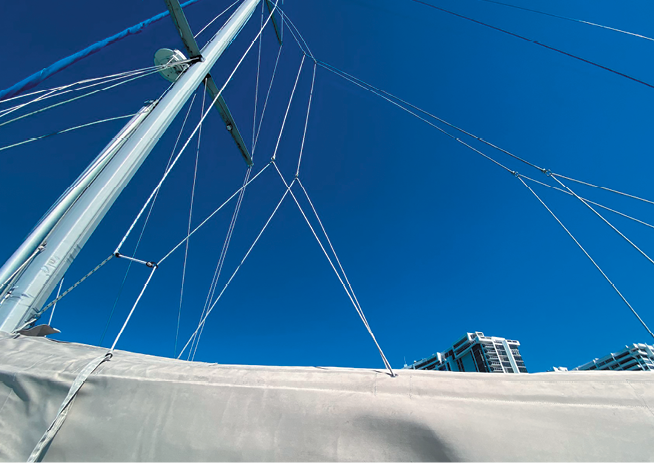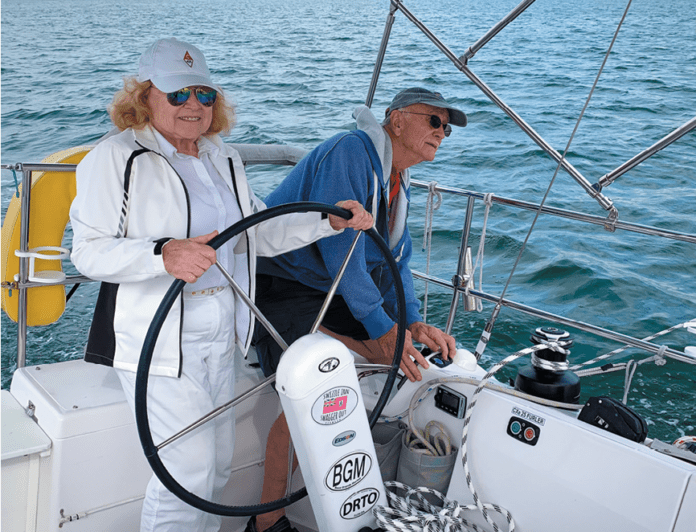TAMING THE MAIN
Your recently updated report on mainsail handling raised some questions (see “Taming the Main: Mainsail Handling for Bigger Boats,” tinyurl.com/bv5f4jfe). My 1985 Brewer 12.8 has a conventional “stackpack.” The problem I have that is the aft portion of the lazy jacks catch my second or third full batten when I hoist the sail.
Could you better explain what you mean by the following: “Many sailors prefer to ease the lines and gather the tackle together just behind the spar, keeping it there until it’s time to douse or reef the sail. Care must be taken to ensure that the lazy jacks are stowed tightly.”
Also unclear was the following: “The most user-friendly systems took into consideration the stack height of the cars used on the mainsail track, and incorporated a block, pendant, and jam cleat tack rather than a tack hook to engage the reef point.”
Will Gerstmyer
Brewer 12.8
South Portland, ME
Sorry about the confusion. To avoid the chance of your lazy jacks snagging battens as the mainsail is set, you can slacken the lazy jacks and draw them forward toward the mast so that they are well clear of the battens when the sail is raised. A cleat or hook on either side of the mast or boom can be used to secure the lazy jacks while you are under way. Regarding the tack hook. Older boats sometimes have a tack hook at the boom gooseneck. Bigger boats with full-batten mainsails will need a tack hook on a pendant or strop that can reach the tack for the reef points. A short webbing strops with a ring eye at the reef point tack instead of a pressed eye at the tack also makes it easier to work around the luff cars of a full-batten main.
LEISURE FURL FAN
Regarding your report on mainsail handling, my wife and I, now in our mid-to-late 50s have sailed our 42-foot sloop for more than 20 years. In the beginning it had a Dutchman system that significantly simplified mainsail handling. About five years ago we installed a Leisure Furl in-boom furling system. We love it. It’s dramatically safer and will undoubtably extend our ability to manage the 370 square-foot main. We reef sooner and more often and neither of us have be on the high part of the deck to secure it. It was well worth the cost that came with replacing the mainsail.

snagging battens.
Sean Davern
New Horizons, Hunter Passage 42
Seattle, WA
TAMING THE MAIN II
Thanks for your detailed report on mainsail handling. I’ve had the Dutchman, lazy jacks, and old-fashioned furling boom. I liked the Dutchman best, for all the reasons you covered. When asked by friends, I recommend it first, even though I now have a Seldén in mast furling system, which I’ve shifted to—mostly because of age.
Russ Hoadly
Blue Heron, Catalina 42
Tampa, FL
QUESTIONABLE KEEL BOLTS
I read your article from several years ago about keel bolts (see Inside PS “Keel Bolt Inspection and Repair,” www.practical-sailor.com/blog/keel-bolt-inspection-and-repair) and found it very helpful and informative. I hope you don’t mind helping me out with a question specifically related to this topic. I recently came into possession of a well-loved 1984 Kirie Elite 29. The boat is in pretty good shape overall, but I was worried about the state of the very aft keel stud and nut. It appears the top nut was replaced and looks okay, the lower nut looks very corroded as does the very tip of the stud. The ballast is 2,310 pounds. It has 1-inch keel studs with nuts. I haven’t had any obvious leaking and the keel/hull joint looks fine. When I went to try to loosen the top nut, the whole stud turns and starts loosening. I’m still a relative novice with this sort of thing and didn’t want to get into more than I can handle, so I didn’t mess with it any further. The boat has an iron, fin keel and my assumption is that the keel stud is threaded into the keel itself, though I’ve had a hard time getting information on this boat as it’s a French manufacture no longer in service. Also, the plate under the nut is a little corroded and should probably be replaced, too. What is your thought on my next steps? I currently have the boat dry docked for a repaint, but the boat yard does not want to take on any liabilities related to keel bolts and just doesn’t work with them, so they haven’t really been helpful.
Sean Kitch
Kirie Elite 29
Charleston, SC
Discerning the condition of keel bolts on a 40-year-old French-built boat can be tricky; we’d recommend getting some professional help before you get in too deep. Your yard should allow outside contractors to assist. Judging from the photos you sent us for review, you don’t have any urgent concerns—but it can’t hurt to have a professional opinion of someone who can visit the boat. With regards to the seized nut, there are several ways to remove the nut without damaging the threads or causing the bolt to loosen (see the Inside PS blog post, “More Bolt Tips: Unsticking Stuck Nuts”); you might have to CAREFULLY use a nut splitter or Dremel to get this one off without unthreading the bolt or damaging threads. Once you’ve got the offending nut off, clean the threads on the bolt with a wire brush and thread chaser, apply some waterproof grease, and snug down a new nut to the specified torque. Fastenal (www.fastenal.com) and other hardware suppliers provide torque values based on bolt diameter; Jboat.org also has a table (tinyurl.com/3sfc9mh6). Note that the nut should be either high quality 316-stainless steel, or Duplex stainless and have clean threads and be well lubricated. If you are intent on a more detailed keel bolt inspection, the customary way is to pull one or two suspicious looking bolts. If one looks bad, you’ll want to pull them all. If you go that route, you’ll definitely want to bring a trusted and experienced advisor into the project.










































